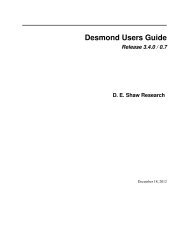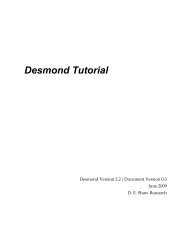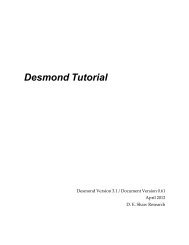Desmond Tutorial
Desmond Tutorial - DE Shaw Research
Desmond Tutorial - DE Shaw Research
- No tags were found...
Create successful ePaper yourself
Turn your PDF publications into a flip-book with our unique Google optimized e-Paper software.
<strong>Desmond</strong> <strong>Tutorial</strong><br />
Preparing Proteins with Missing Residues or Side Chains<br />
To run Prime:<br />
1. Download the 1su4 structure as shown in Figure 1.4 on page 5. This structure has all<br />
residues present in the PDB file, but as a working example, we will delete a small<br />
loop by hand‐editing the PDB file.<br />
2. Delete residues 132–136 from the 1su4 PDB file by hand (the original PDB file should<br />
be in the working directory after the download) and save it as<br />
1su4_missing_loop.pdb.<br />
3. Import the modied PDB structure into Maestro as shown on Figure 1.3 on page 4.<br />
The truncated structure replaces the full structure in the Workspace where the missing<br />
loop is called out in a red box in Figure 3.1.<br />
Figure 3.1 Missing loop in the 1su4 protein<br />
The loop between the two<br />
orange ribbons is<br />
missing.<br />
The white gaps in the<br />
residues (shown in green)<br />
represents the missing<br />
loop.<br />
NOTE<br />
NOTE<br />
4. Apply Prime to the truncated 1su4 protein structure with the missing loop.<br />
Running Prime can be computationally intensive. To save time, you can distribute Prime<br />
jobs among multiple CPUs.<br />
If your protein only has missing side chains (no missing residues), you can select the Predict<br />
side chains task under Applications > Prime > Refinement to automatically fill in the<br />
missing residues without running the entire Prime structure prediction protocol as<br />
shown in Figure 3.2.<br />
30 D. E. Shaw Research September 2008






